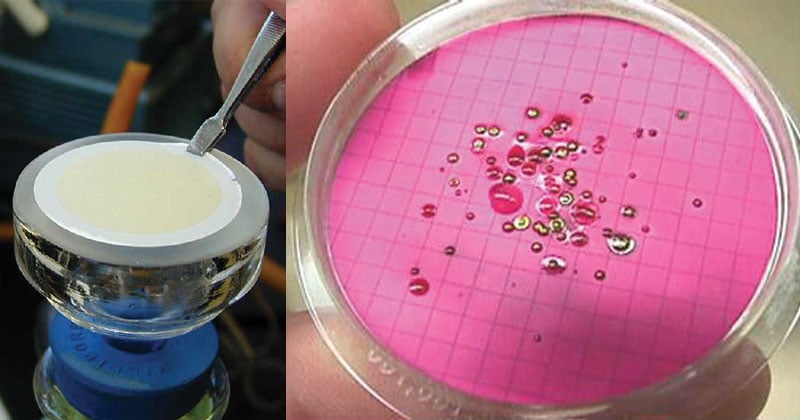- The Membrane Filter (MF) Technique was introduced in the late 1950s as an alternative to the Most Probable Number (MPN) procedure for microbiological analysis of water samples.
- It involves the use of membrane filters, which are thin porous sheet structures composed of cellulose esters or similar polymeric materials.
- They act essentially as two-dimensional screens and as such, all particles, both biological and non-biological, which exceed the pore size, are retained upon the surface of the filter from fluids passing through.
- Bacteria-tight membrane filters capable of retaining microorganisms larger than 0.45 micrometer (μm) are frequently used for analysis of water.

Interesting Science Videos
Objective of Membrane Filter (MF) Technique
To determine the quality of water samples using the membrane filter method.
Principle of Membrane Filter (MF) Technique
Membrane filters have a known uniform porosity of predetermined size (generally 0.45 µm) sufficiently small to trap microorganisms. A water sample is passed through a sterile membrane filter that is housed in a special filter apparatus contained in a suction flask. Following filtration, the filter disc that contains the trapped microorganisms is aseptically transferred to a sterile Petri dish containing a pad saturated with the appropriate medium. The passage of nutrients through the filter during incubation facilitates the growth of organisms in the form of colonies, on the upper surface of the membrane. Membrane filtration and colony count techniques assume that each bacterium, clump of bacteria, or particle with bacteria attached, will give rise to a single visible colony. Each of these clumps or particles is, therefore, a colony forming unit (cfu) and the results are expressed as colony forming units per unit volume. Discrete colonies thus formed can be easily transferred to confirmation media. Following incubation, the colonies present on the filter are counted with the aid of a microscope.
Procedure of Membrane Filter (MF) Technique
- Collect the sample and make any necessary dilutions.
- Select the appropriate nutrient or culture medium. Dispense the broth into a sterile Petri dish, evenly saturating the absorbent pad.
- Flame the forceps, and remove the membrane from the sterile package.
- Place the membrane filter into the funnel assembly.
- Flame the pouring lip of the sample container and pour the sample into the funnel.
- Turn on the vacuum and allow the sample to draw completely through the filter.
- Rinse funnel with sterile buffered water. Turn on vacuum and allow the liquid to draw completely through the filter.
- Flame the forceps and remove the membrane filter from the funnel.
- Place the membrane filter into the prepared Petri dish.
- Incubate at the proper temperature and for the appropriate time period.
- Count the colonies under 10 – 15 X magnification.
- Confirm the colonies and report the results.
Uses of Membrane Filter (MF) Technique
- It is used to analyze a series of dilutions of water samples collected upstream and downstream from an outlet of a sewage treatment plant.
- EPA-approved guidelines for the determination of fecal contaminating organisms (EPA Method 1103.1) are routinely utilized worldwide to examine water samples before treated water is released into a nation’s waterways.
- A total count of coliform bacteria determines the potability of the water sources.
- Delicate media components that cannot withstand steam sterilization by autoclaving (e.g., serum, certain carbohydrate solutions, certain antibiotics, and other heat-labile substances) can be sterilized by membrane filtration.
- The pharmaceutical and cosmetics industries typically focus on monitoring their process water for Pseudomonas species.
Merits of Membrane Filter (MF) Technique
- Results are available in a shorter period of time
- Larger volumes of sample can be processed
- Because of the high accuracy of this method, the results are readily reproducible.
- Allows isolation and enumeration of discrete colonies of bacteria
- Allows for removal of bacteriostatic or cidal agents that would not be removed in Pour Plate, Spread Plate, or MPN techniques.
- It involves less preparation than many traditional methods, and is one of a few methods that will allow the isolation and enumeration of microorganisms.
Limitations of Membrane Filter (MF) Technique
- During the processing of turbid specimens that contain large quantities of suspended materials; particulate matter clogs the pores and inhibits passage of the specific volume of water.
- When small quantities of sample (for example, of sewage effluent or of grossly polluted surface water) are to be tested, it is necessary to dilute a portion of the sample in sterile diluent to ensure that there is sufficient volume to filter across the entire surface of the membrane.
References
- https://www.pall.com/en/laboratory/microbiology-qc/laboratory-membrane-filter-technique.html
- https://www.membrane-solutions.com/News_80.htm
- https://www.sciencedirect.com/science/article/pii/S0580951708701387
- http://www.who.int/water_sanitation_health/resourcesquality/wqmchap10.pdf
- http://www.labdepotinc.com/admin/uploads/9222_a.pdf
- http://europepmc.org/backend/ptpmcrender.fcgi?accid=PMC547049&blobtype=pdf
- https://aem.asm.org/content/aem/34/1/42.full.pdf

Bagaimana cara memvalidasi metode membran filter
Thank you very much,it’s very easy to understand
Easy to follow thank you
The note is eazy for understanding. I need more of it
Thank you very much for this great, direct, and easy explanation.
good and easy to understand
the notes are effective because they are easy to read and understand